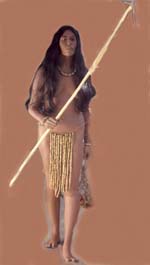Physical Anthropology
 Descriptions of the physical characteristics of the peninsula’s native peoples can be found in historical sources since the first European contacts. Among the early explorers giving such accounts were Nicolás de Cardona in 1615, Sebastían Gutiérrez y Esteban Carbonel de Valenzuela in 1632, Diego de Nava in 1634, Alonso González Barriga in 1644, Francisco de Lucenilla in 1668, Eusebio Francisco Kino y Isidro Atondo y Antillón in 1683-1685, Woodes Rogers in 1710, and George Shelvocke in 1721.
Descriptions of the physical characteristics of the peninsula’s native peoples can be found in historical sources since the first European contacts. Among the early explorers giving such accounts were Nicolás de Cardona in 1615, Sebastían Gutiérrez y Esteban Carbonel de Valenzuela in 1632, Diego de Nava in 1634, Alonso González Barriga in 1644, Francisco de Lucenilla in 1668, Eusebio Francisco Kino y Isidro Atondo y Antillón in 1683-1685, Woodes Rogers in 1710, and George Shelvocke in 1721.
Subsequent descriptions came from Jesuit missionaries and historians: Juan María de Salvatierra, Miguel del Barco, Juan de Ugarte, Jakob Baegert, Francisco María Piccolo, Jaime Bravo, Ignacio María Napoli, Miguel Venegas, and Francisco Xavier Clavijero, among others.
Although disagreements exist concerning some details, such as skin color and type of hair, almost all of the historical sources agree in saying that the Indians were of good appearance: tall, robust, stout, strong, brawny, and healthy, with their long hair gathered up, their pierced ears, and naked.
Later, in what may be considered the first physical anthropological study, the Dutch investigator Herman Frederik Carel Ten Kate studied skeletal remains from several caves in the southern part of the peninsula in 1884. He concluded (a) that there existed a native race whose main characteristic was their dolichocephaly and hypsistenocephaly (long, extremely narrow heads), (b) that they had traits making them similar to the Melanesians and the early people of Lagoa Santa in Brazil, and (c) they were taller than average (1.65 m, or 5′ 5″). Later, in 1905 the geologist León Diguet completed a similar study which supported Ten Kate.
In 1909, Paul Rivet analyzed the statistics of Ten Kate and Diguet, confirming their results and reporting a close morphological similarity with the Lagoa Santa population. Based on the earlier results and a wide-ranging ethnographic study, Rivet proposed a new source for the settling of the Americas: a trans-Pacific migration in rafts from Melanesia.
Despite the interest of this bold hypothesis, further studies of these populations were not made until 1977, when the physical anthropologist Arturo Romano Pacheco studied skeletal remains excavated by William C. Massey in 1947 and gave a morphological description of the cranea of both sexes. The skulls were of medium craneal capacity, long, high relative to their width, with wide frontals, medium-sized crests, and wide palates. However, there was little consistency in craneal height relative to length, frontal curvature, foramen magnum, type of face, orbits, nose, or mandibles. Comparing his results with those for other long-headed (dolichocephalic) populations, he concluded that there were notable differences distinguishing the Baja California Sur remains from those of continental groups. In another study in the same year, Romano reported on differences in craneal development; these results were less definitive in that they only served to distinguish the male cranea, leaving the female ones uncertain.
Rose Tyson reported in 1977 on her osteometric study of the prehispanic populations’ physical characteristics and confirmed the unusual form of the cranea. In the same year, José Antonio Pompa y Padilla made a study of developmental characteristics in teeth and compared his results with those for other world populations, in Hawaii, Alta California, New Guinea, Polynesia, Japan, and among the Eskimos. He concluded that there was insufficient evidence to sustain the theory of a Melanesian origin for the Californians, although he considered that a migration from the north or a possible Polynesian origin could not be ruled out. Later, in 1990, the same author compared his observations with those for a western Mexican population (from Marismas Nacionales, in Nayarit) and two Mesoamerican populations (from Tlatelolco D.F. and Chichén Itzá in Yucatan). He concluded that there was a direct relation between geographical distance and the resemblances between populations. The closest affinity with the Californians was shown by the sample from Marismas Nacionales, followed by that from Tlatelolco and finally the one from Yucatan.
In 1994, physical anthropologists Alfonso Rosales López and Leticia C. Sánchez García began an investigation of Californian craneal morphology. They used the multivariate technique of principal components analysis, working with a battery of 24 craneometric measurements. The data were analyzed both by sex and by population; however, because of the small sample size, it was not possible to define geographical differences, only differences by sex. Nonetheless, it was possible to determine the statistical patterns of California cranea and to confirm that a high level of endogamism must have existed among these populations.
Finally, making use of this study, the painter Rafael Dávalos reconstructed the appearance of the Californians in two murals representing native life. Afterwards, researchers at the Museum of Natural History of the Universidad Autónoma de Baja California Sur, including the biologists Luis Alberto Herrera Gil and Francisco Reynoso and the archaeologist Fermín Reygadas Dahl, made four physical anthropological reconstructions which are exhibited in the Museum of the Missions (Loreto), the Cultural Center Museum (Tijuana), and the National Museum of Anthropology (Mexico City).
© 2002 Alfonso Rosales López
Centro INAH Baja California Sur
(Translated by Don Laylander)